The Ultimate Guide to Amazon Bookkeeping for Your E-commerce Business in 2024
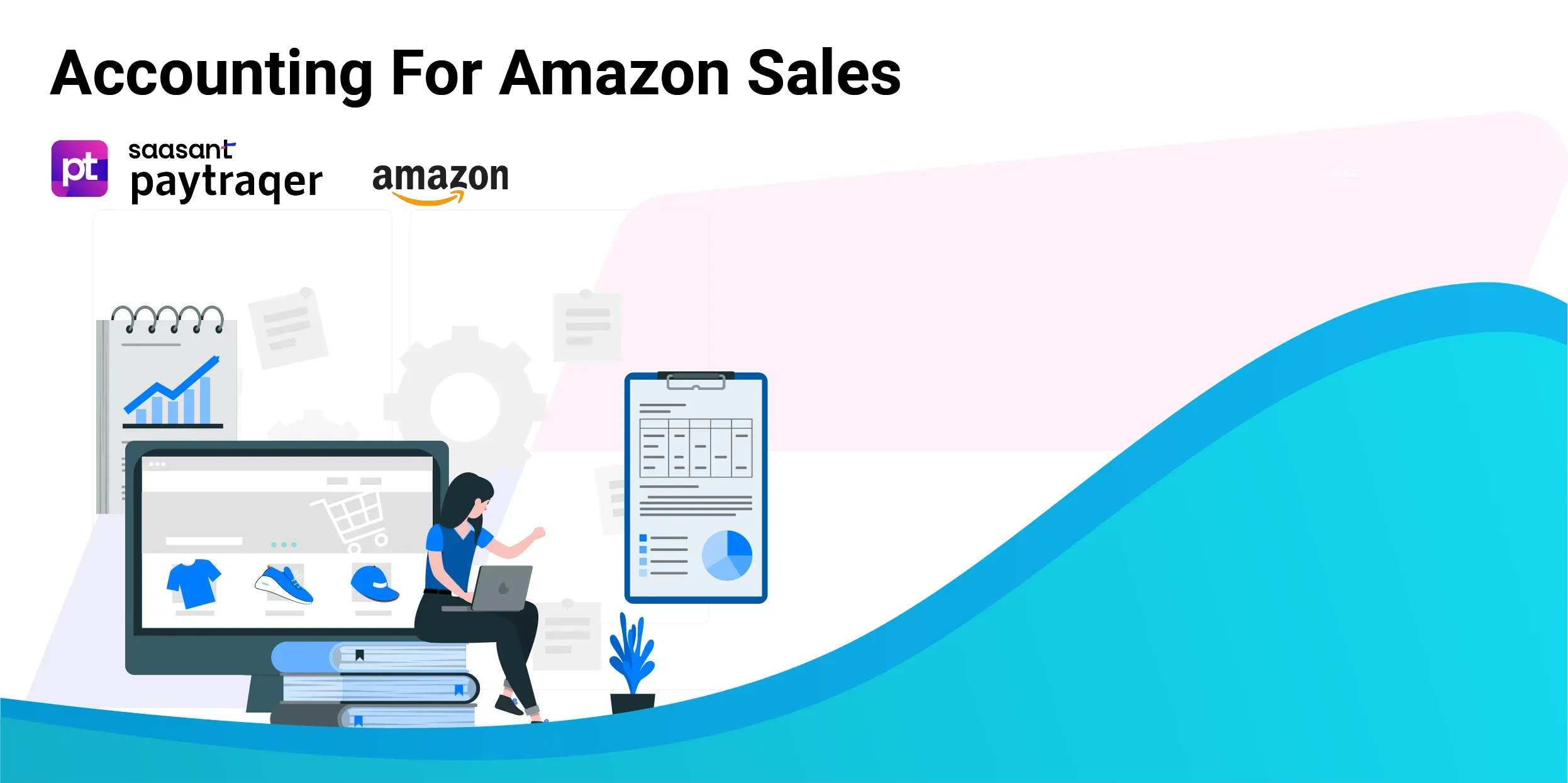
If you are an Amazon seller, you know how exciting and rewarding it can be to run an online business. You also know how challenging and complex it can be to manage your finances. Accounting and bookkeeping are essential skills for any Amazon seller who wants to succeed and grow their business. However, many sellers need help keeping track of their sales, expenses, taxes, and inventory.
That’s why you need suitable applications and systems to make your accounting and bookkeeping more effortless and accurate. Discover a guide designed to streamline accounting and bookkeeping for your Amazon business, saving you valuable time, and money, and the inevitable headaches. Elevate your financial control, redirect your focus toward business growth, and unlock the full potential of your earnings. Ready to embark on this journey? Let's dive in!
Contents
Building an Amazon Accounting Tech Stack
Effective Reconciliation of Sales and Fees
Efficient Inventory and COGS Tracking
Detailed Profit and Loss Reporting
Choosing the Right Integration Software
What is Amazon Bookkeeping?
What Does an Amazon Bookkeeper Do?
FAQs
Building an Amazon Accounting Tech Stack
An Amazon accounting tech stack is the collection of tools, platforms, apps, and software you use to manage your accounting and bookkeeping for your Amazon business. A tech stack can help you automate and streamline your accounting and bookkeeping tasks, saving time, money, and errors. A tech stack can also help you improve your financial visibility, control, and decision-making.
Creating a well-rounded Amazon accounting tech stack involves assembling various tools, platforms, and software to streamline and automate your financial processes. This saves time, reduces errors, and enhances financial visibility and decision-making capabilities.
One essential application for managing your Amazon business's financial aspects is PayTraQer, an integration management software. This software connects widely used accounting platforms like QuickBooks Online or Xero with payment processors (such as PayPal, Stripe, or Square) and e-commerce platforms like Amazon, Shopify, and eBay.
Effective Reconciliation of Sales and Fees
Precise recording of Amazon transactions is fundamental for effective financial management. This involves capturing essential customer information, fees, line items, and taxes and handling multi-currency transactions. Streamlining the reconciliation process is further facilitated by syncing payouts and bank deposits. This meticulous approach ensures a comprehensive and error-free record of your financial activities on the Amazon platform.
Efficient Inventory and COGS Tracking
To thoroughly understand your Amazon business, it's crucial to track inventory levels, costs, and profits effectively. This involves syncing inventory and Cost of Goods Sold (COGS) data with your accounting platform, providing seamless margins and cash flow monitoring. This integrated approach ensures a streamlined and effortless overview of your business's financial health on the Amazon platform.
Detailed Profit and Loss Reporting
Creating meaningful profit and loss reports is essential for gaining valuable insights into the financial well-being of your Amazon business. This process involves leveraging synced data from accounting platforms such as QuickBooks or Xero to ensure the accuracy of your reports. Furthermore, customization options allow you to tailor these reports based on various parameters, including date, product, channel, or category. This flexibility empowers you to delve deeper into specific aspects of your financial performance, fostering a comprehensive understanding of your Amazon business's financial landscape.
Choosing the Right Integration Software
Choosing intuitive and user-friendly integration software ensures a seamless financial management process. When selecting a solution, prioritize software that offers straightforward setup, unlimited support, and comprehensive onboarding services. Many providers understand the importance of flexibility and cater to different business needs and budgets by providing free trials and adaptable pricing plans. This approach allows you to test the software's compatibility and assess its suitability for your requirements, ensuring a smooth and tailored integration into your Amazon business's financial ecosystem.
You can establish a reliable and efficient financial management system by incorporating effective integration software like PayTraQer into your Amazon accounting tech stack.
What is Amazon Bookkeeping?
Amazon bookkeeping refers to keeping accurate financial records for an e-commerce sales or business that sells on Amazon. It involves tracking all transactions related to your Amazon sales, such as product sales, refunds, fees, and other expenses.
Proper bookkeeping helps you understand the financial health of your Amazon business, make informed decisions about pricing, inventory, and expenses, keep business bills, and stay compliant with tax regulations.
Some critical tasks in Amazon bookkeeping include recording sales and expenses in a ledger, reconciling bank statements, tracking and purchasing inventory, and generating financial reports such as profit and loss statements and balance sheets.
While it can be time-consuming, maintaining a proper accounting system and bookkeeping records is essential for the success of any Amazon business, as it provides the necessary insights to make informed business decisions, accurately calculate taxes owed, and keep your finances in order.
What Does an Amazon Bookkeeper Do?
An Amazon bookkeeper maintains accurate financial records for an e-commerce business that sells on Amazon. Here are some of the critical tasks that an Amazon bookkeeper typically performs:
Set up and maintain a chart of accounts to categorize income and expenses.
Record all Amazon transactions in a ledger or accounting software, including sales, refunds, fees, and other costs.
Reconcile bank and credit card statements to ensure the accuracy and completeness of financial records.
Track inventory levels and value to ensure accurate cost of goods sold (COGS) calculations.
Generate financial reports, such as profit and loss statements and balance sheets, to evaluate business performance and make informed decisions.
Calculate and file taxes owed, including sales and income tax, in compliance with applicable laws and regulations.
Maintain organized records and backup documentation for audits and tax purposes.
Provide financial analysis and insights to help the business owner make informed pricing, inventory, and expenses decisions.
Keep up-to-date with changes in tax laws and regulations that may impact the business.
Why Bookkeeping for Amazon Sellers?
Bookkeeping is essential for Amazon sellers for several reasons:
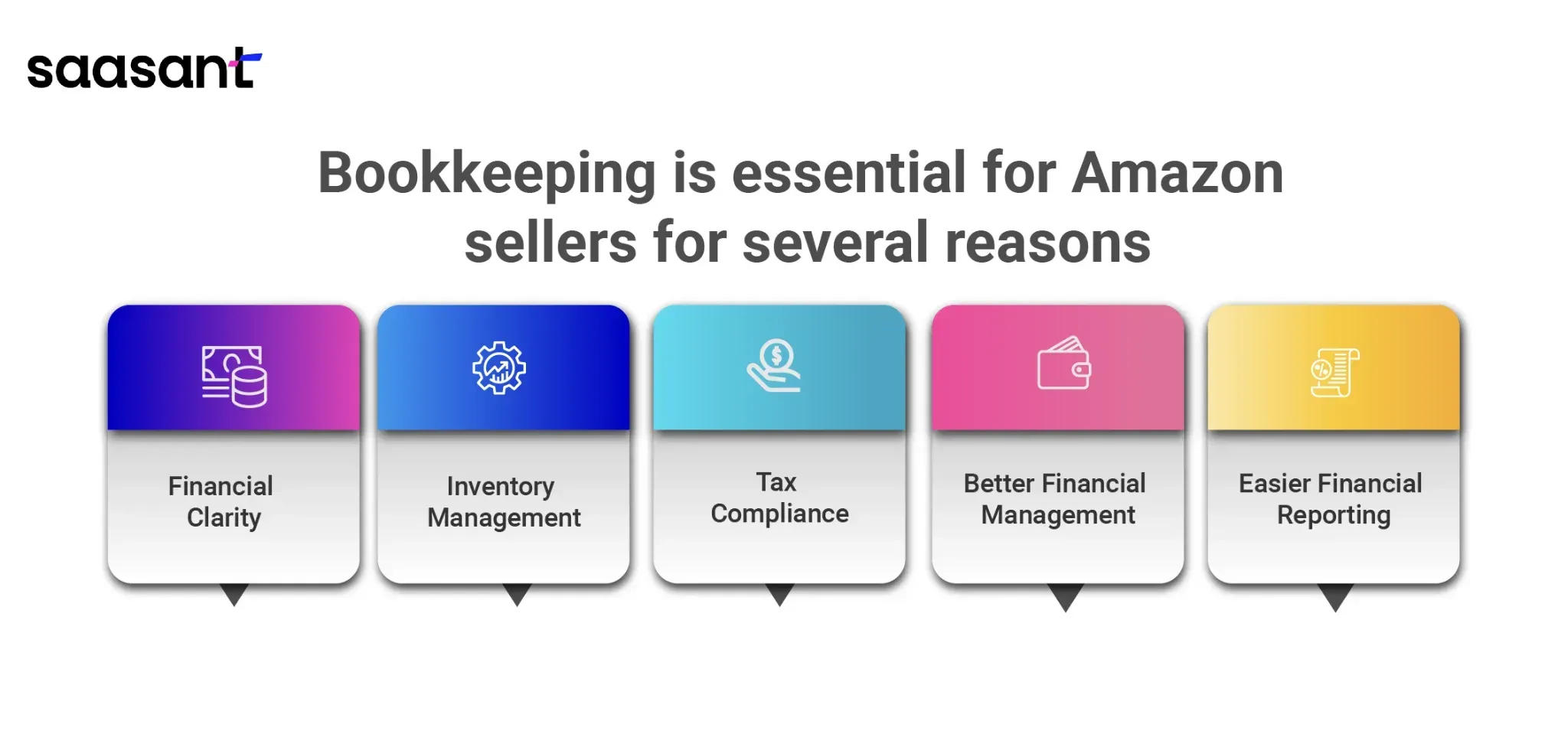
Financial Clarity
Accurate bookkeeping allows Amazon sellers to understand their business’s financial health clearly. It offers valuable insights into the company's cash flow, revealing both inflows and outflows of money and identifying where expenditures occur. This information is critical for making informed business decisions and identifying opportunities for growth and improvement.
Inventory Management
Monitor Inventory Levels: Proper bookkeeping tracks inventory purchases, sales, and adjustments, crucial for maintaining optimal inventory levels.
Cost of Goods Sold (COGS): Accurately calculating COGS is essential for understanding the true profitability of products sold on Amazon.
Cash Flow Management: Bookkeeping helps monitor cash flow, ensuring the business has enough cash to cover operational expenses.
Managing Payments: Amazon typically pays sellers every two weeks, so managing finances between these payment periods is essential.
Attracting Investors or Loans: If a seller seeks external funding, lenders or investors will require detailed financial statements to assess the business's health.
Tax Compliance
Amazon sellers are subject to various tax obligations, including sales tax, income tax, and other tax requirements. Accurate bookkeeping is essential for calculating taxes owed and ensuring compliance with tax laws and regulations. Proper bookkeeping also helps to minimize the risk of audits and penalties for non-compliance.
Better Financial Management
Bookkeeping allows Amazon sellers to keep track of their expenses, including fees, refunds, and other costs associated with running their business. This information can help sellers optimize their profitability by identifying areas where payments can be reduced or eliminated.
Easier Financial Reporting
Good bookkeeping practices make it easier to generate financial reports, such as profit and loss statements and balance sheets. These reports provide a clear picture of the business’s financial performance and help track progress and set financial goals.
Amazon Bookkeeping Software
Several bookkeeping and accounting software options are now available for Amazon sellers to help them manage their financial records efficiently. Here are some of the popular Amazon bookkeeping and accounting software options, along with their features and benefits:
QuickBooks
It is a popular accounting software that provides a range of bookkeeping features such as invoice generation, expense tracking, bank reconciliation, and financial reporting. It integrates seamlessly with Amazon Seller Central and helps sellers manage their finances and stay on top of their tax obligations.
Amazon to Quickbooks Bookkeeping
Amazon is the world’s largest online retailer, a multinational technology company that operates in various business segments, including e-commerce, cloud computing, digital streaming, and artificial intelligence. On the other hand, QuickBooks is a popular bookkeeping software businesses use to manage their financial records.
Many businesses use tools like PayTraQer to connect their Amazon sales with QuickBooks bookkeeping easily. This is especially handy when they want to bring important data from Amazon to QuickBooks for a complete financial picture. For instance, a growing e-commerce store aiming for a consolidated financial overview might utilize PayTraQer to effortlessly synchronize sales information, ensuring a smooth and accurate integration of Amazon data into their QuickBooks system. This practical application showcases the tangible benefits of such integrations in enhancing the efficiency and accuracy of financial management for businesses operating on the Amazon platform.
These integrations rely on Amazon and QuickBooks' application programming interfaces (APIs), enabling smooth communication and efficient data transfer between the two platforms. By establishing this connection, businesses can streamline their bookkeeping processes, ensuring accurate and up-to-date financial records and facilitating better financial management and decision-making.
With the integration successfully established, businesses can automate the seamless recording of Amazon sales transactions, fees, and pertinent financial data directly into QuickBooks. This transformative process enhances efficiency and delivers significant cost and time savings. The automation eliminates the need for manual data entry, mitigating the risk of errors associated with traditional methods. By leveraging this integration, businesses can ensure accuracy, optimize resources, and streamline their financial workflows for a more productive and error-free bookkeeping experience.
You can automate specific tasks such as creating and updating invoices, tracking inventory levels, reconciling bank accounts, and generating financial reports. Businesses can also set up rules and filters to categorize transactions and streamline the bookkeeping process.
In conclusion, connecting Amazon to its QuickBooks online bookkeeping can help businesses better manage their finances, improve accuracy and efficiency, and make more informed decisions based on real-time data.
Xero
Another widely used online accounting system that helps Amazon sellers manage their finances. It offers features in invoicing, expense tracking, bank reconciliation, and financial reporting. It also integrates with Amazon Seller Central and other third-party e-commerce platforms.
TaxJar
TaxJar is a software designed to help Amazon sellers manage their sales tax compliance. It integrates with various e-commerce platforms, including Amazon Seller Central, and automatically calculates and reports sales tax owed to different states.
Sellerboard
Sellerboard is a cloud-based accounting and analytics software designed for Amazon sellers. It offers profit and loss statements, inventory management and tracking, and sales analytics. It integrates with Amazon Seller Central and other marketplaces and provides real-time data on business performance.
How Do You Choose the Best Bookkeeping Software for an Amazon Business Owner?
With such vast bookkeeping software options, selecting the ideal fit for Amazon sellers can be overwhelming. Here are some factors to consider when choosing bookkeeping software for your Amazon business:
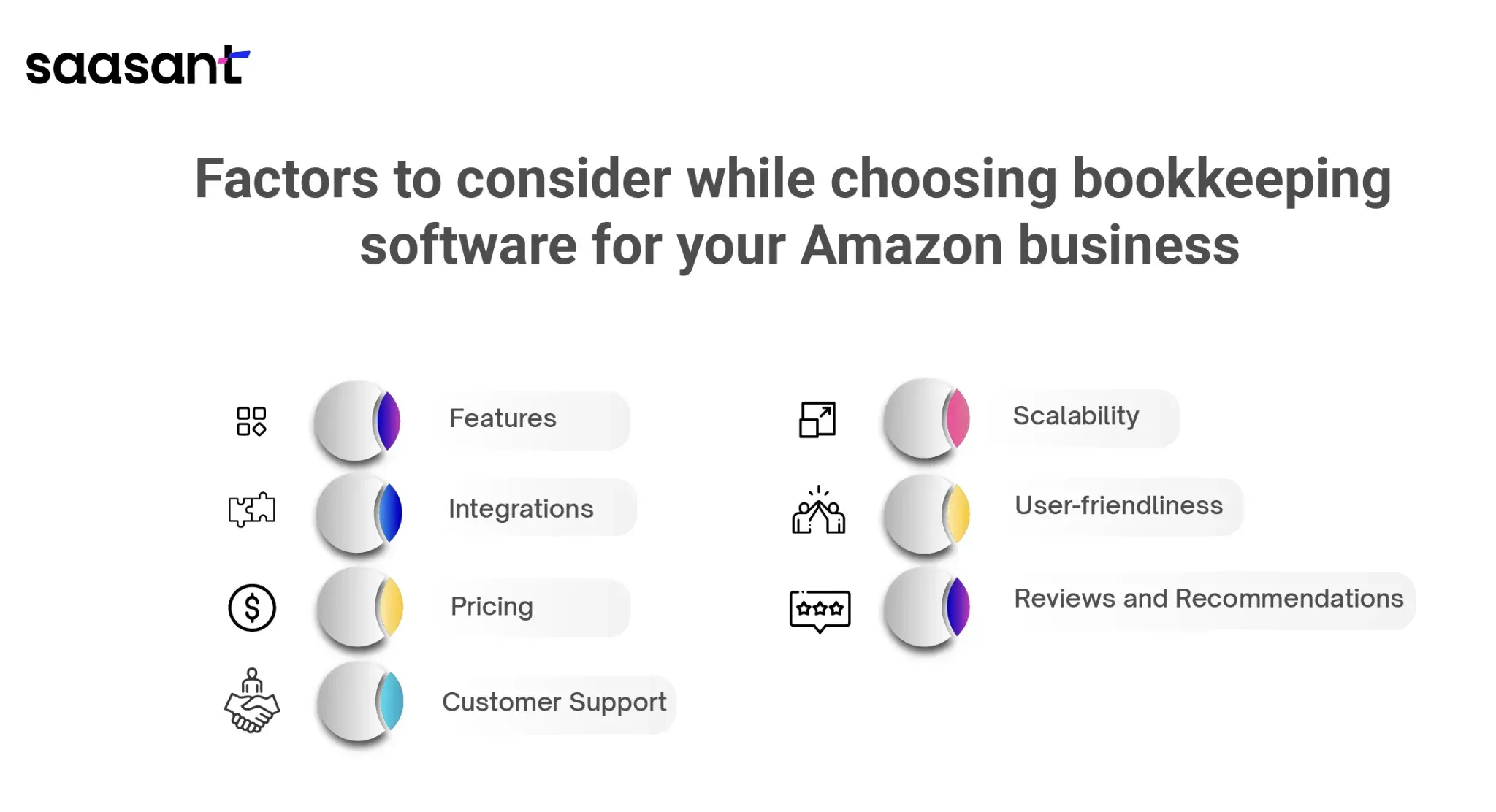
Features
Consider bookkeeping software's features, such as invoicing, expense tracking, bank reconciliation, and multi-currency support.
Integrations
Look for bookkeeping software that integrates seamlessly with Amazon Seller Central and other e-commerce platforms. It will help streamline your bookkeeping process and make it easier to manage finances across different channels.
Pricing
Consider the pricing plans of different bookkeeping software options and choose the one that fits your budget. Many other free accounting software options offer different pricing plans depending on the number of users or the specific features included.
Scalability
Consider whether the right accounting software can scale as your Amazon business grows. Look for software to accommodate your business’s growth and offer features that meet your changing needs.
User-friendliness
Look for bookkeeping software that is easy to use and has a user-friendly interface. It will make it easier to manage your finances and reduce the likelihood of errors.
Reviews and Recommendations
Explore reviews from fellow Amazon sellers to gain insights into their experiences. Additionally, seek recommendations from accountants or business advisors specializing in e-commerce for valuable insights.
Customer support
Consider the level of customer support offered by the bookkeeping software provider. Look for software that offers reliable customer support, such as email or phone support, to help you resolve any issues.
By considering these factors, you can choose bookkeeping software that meets the specific needs of your Amazon business and helps you manage your finances effectively.
How to Do Accounting for Amazon Sales: A Guide for FBA Sellers
Are you an Amazon seller who wants to keep track of your finances and taxes? If so, you need to know how to do accounting for Amazon sales. Accounting is the process of recording, organizing, and analyzing your business transactions. It helps you monitor your income, expenses, profits, and cash flow. It also enables you to prepare and file your tax returns promptly.
What is FBA, And How Does It Affect Your Accounting?
FBA stands for Fulfillment by Amazon, a service that allows you to store your inventory in Amazon’s warehouses and let them handle the packing, shipping, and customer service for your orders. FBA can save you time and money and increase your sales and customer satisfaction.
However, FBA also adds some complexity to your accounting, as you must deal with various fees, charges, and reimbursements from Amazon. Some of the most common FBA fees include:
Storage fees: These are monthly fees for the space your inventory occupies in Amazon’s warehouses. They vary depending on the size and weight of your products and the season and demand.
Fulfillment fees: You pay for each unit that Amazon picks, packs, and ships to your customers. They also vary depending on the size and weight of your products and the shipping method and destination.
Referral fees: These are fees that you pay for each sale that you make on Amazon’s platform. They are a percentage of the total sales price, usually between 8% and 15%, depending on the product category.
Other fees: These are fees that you may incur for other services or situations, such as long-term storage fees, removal fees, disposal fees, return fees, refund fees, advertising fees, subscription fees, etc.
You need to track and record all these fees accurately, as they affect your income and expenses, as well as your inventory and cash flow. You must also reconcile your Amazon statements with your bank and accounting records to ensure correct payment and identify discrepancies or errors.
What Are Some of the Accounting Challenges Faced by Amazon Sellers?
Besides the FBA fees, there are other accounting challenges that you may face as an Amazon seller, such as:
Sales tax: As an Amazon seller, you may have to collect and remit sales tax in the states where you have a physical presence or a nexus. It can be complicated, as different states have different rules, rates, and thresholds for sales tax. With PayTraQer, you can efficiently track the sales tax that Amazon collects and remits on your behalf and the sales tax you handle independently, ensuring easy compliance.
Inventory valuation: As an Amazon seller, you must value your inventory at the end of each accounting period to calculate your cost of goods sold (COGS) and gross profit. There are different methods to value your inventory, such as FIFO (first-in, first-out), LIFO (last-in, first-out), or average cost. You need to choose a consistent and appropriate method for your business and apply it correctly.
Currency conversion: As an Amazon seller expanding into global markets, managing transactions in currencies like the US dollar, Canadian dollar, Euro, British pound, and more is a common challenge. PayTraQer simplifies this process by automatically handling currency conversions based on real-time exchange rates at the time of each transaction. It ensures accurate accounting in your home currency and helps you stay on top of gains or losses resulting from currency fluctuations. With PayTraQer, managing your international sales becomes a seamless part of your overall financial strategy.
These are some accounting challenges you may encounter as an Amazon seller. You must know and handle them properly to avoid errors, penalties, or audits.
How Do You Set up Your Amazon Accounting System and Process?
Once you have chosen your accounting software, you must set up your Amazon accounting system and process. It involves the following steps:
Create your Amazon seller account and link it to your accounting software.
Set up your chart of accounts and categories for your income and expenses.
Set up your sales tax settings and rates for the states where you have a nexus.
Set up your inventory settings and the valuation method.
Set up your currency settings and exchange rates.
Set up your reporting settings and preferences.
After you have set up your Amazon accounting system, you need to follow a regular accounting process, which includes the following steps:
Import your sales and fees data from Amazon and other channels to your accounting software. Use PayTraQer to seamlessly import sales and fee data from Amazon and other channels into your accounting software. With PayTraQer's assistance, effortlessly review and categorize transactions, ensuring accurate matching with your bank statements.
Record and track your FBA fees and reimbursements.
Manage and value your inventory and adjust for any discrepancies.
Collect and remit your sales tax and file your sales tax returns.
Convert and report your foreign currency transactions and account for any gains or losses.
Generate and analyze your financial reports, such as your income statement, balance sheet, and cash flow statement.
Prepare and file your income tax returns and pay your income tax.
Following these steps ensures that your Amazon accounting is accurate, complete, and up-to-date.
How Do You Report and Pay Your Taxes as an Amazon Seller?
As an Amazon seller, you must report and pay two types of taxes: sales and income. You collect sales tax from your customers and remit it to the state and local governments where you have a nexus. Income tax is a tax that you pay on your net profit from your Amazon business.
Sales Tax
You collect sales tax from your customers and remit it to the state and local governments where you have a nexus. A nexus is a physical presence or a connection that triggers your sales tax obligation. For example, you may have a nexus in a state if you have an office, a warehouse, an employee, or an inventory there. You may also have a nexus in a state if you exceed a certain amount of sales or transactions in that state.
To report and pay your sales tax, you need to follow these steps:
Register for a sales tax permit in each state where you have a nexus. You can do this online or by mail, depending on the state. You must provide your personal and business information and your Amazon seller account details.
Collect sales tax from your customers at the appropriate rate for each state and locality. You can automate this process using Amazon’s tax calculation service or a third-party app. You can also set up tax rules in your seller account settings.
File sales tax returns and regularly remit the collected sales tax to each state. The frequency and deadline of your sales tax filing depend on the state and your sales volume. You can file your sales tax returns online or by mail, depending on the state. You will need to report your total sales, taxable sales, and sales tax collected for each state and locality.
As part of prudent financial management, it's crucial to maintain records of your sales and tax transactions. It ensures compliance and prepares you for potential audits or disputes. Applications like PayTraQer can be instrumental in this process, offering secure and organized record-keeping capabilities. By utilizing PayTraQer, businesses can efficiently manage and store their transaction records, making retrieving necessary information seamless and stress-free, especially during audits or dispute resolutions.
Income Tax
Income tax is a tax that you pay on your net profit from your Amazon business. Your net profit is your total income minus your total expenses. Your income includes sales revenue, FBA fees, reimbursements, and other income sources. Your expenses include the cost of goods sold, shipping, advertising, software, and other business expenses.
To report and pay your income tax, you need to follow these steps:
Track and record your income and expenses throughout the year. You can use accounting software or a spreadsheet to organize and categorize your transactions. You will need to keep receipts and invoices for your expenses as proof.
Receive Form 1099-K from Amazon at the end of the year. Form 1099-K is a tax form that reports your gross sales and transactions on Amazon. The IRS requires Amazon to send Form 1099-K to all sellers who have made over $20,000 in gross sales and have had over 200 transactions in a calendar year.
File Schedule C or Form 1040 with the IRS. Schedule C is a tax form that reports your income and expenses from your Amazon business. You must calculate your net profit and self-employment tax on Schedule C. Form 1040 is the main tax form that reports your income and deductions from all sources. You must include your net profit and self-employment tax from Schedule C on Form 1040.
Pay your income tax and self-employment tax to the IRS. Your income tax depends on your taxable income and your tax bracket. Your self-employment tax depends on your net profit and the Social Security and Medicare rates. Depending on your preference, you can pay your taxes online or by mail. You may also need to pay estimated taxes quarterly if you expect to owe more than $1,000 in yearly taxes.
These are the basic steps to report and pay your taxes as an Amazon seller. However, tax laws and regulations may vary depending on your situation and location. Therefore, consulting a tax professional or accountant for more guidance and assistance is advisable.
How to Do Bookkeeping for Amazon Sellers?
Here are some critical steps for doing basic accounting and bookkeeping for Amazon Sellers, with examples to make you understand:
Set Up a Bookkeeping System
Open a dedicated bank account for your Amazon business, Then create a chart of accounts to track your income and expenses. For example, you can set up a “Sales Income” account to track revenue from Amazon sales with an opening balance of $0.
Record Sales Transactions
Record all sales transactions from Amazon, including the order date, item description, price, and associated fees. Let’s say you sold 100 units of a product for $10 each, with a referral fee of 15% and a closing fee of $1.80; your total revenue would be $1,000, with a referral fee of $150 and a closing fee of $180. Record the sales income and fees in the chart of two separate accounts. For example, record $1,000 in the “Sales Income” account and $150 in the ‘Referral Fees’ account.
Record Expenses
Record all expenses associated with your Amazon business, including product costs, shipping fees, storage fees, and any other business-related expenses. For example, if you paid $500 for inventory, $100 for shipping, and $50 for storage fees, your total expenses would be $650. Record the costs in the chart of accounts. Then, record $500 in the “Inventory” account, $100 in the ‘Shipping’ account, and $50 in the “Storage Fees” account.
Reconcile Accounts
Ensure accurate recording of all transactions by reconciling your bank, credit card, and Amazon payment accounts. Let’s say you received a fee of $950 from a personal credit card from Amazon but only recorded $900 in sales; you would need to reconcile the difference of $50. Record the reconciliation in the chart of your accounts payable by recording the $50 discrepancy in the “Miscellaneous Income or Expense” account.
Generate Financial Reports
Use bookkeeping software to generate financial reports, such as profit and loss statements, cash flow statements, and balance sheets. For example, your profit and loss statement would show your revenue of $1,000 and expenses of $650, resulting in a net profit of $350.
File Taxes
Use your financial and accounting records to file taxes accurately and on time. Be sure to include all income and expenses associated with your Amazon business. For example, if your net profit for the current year is $5,000, you would need to report that on your tax return or consult a professional tax accountant.
Monitor Inventory
Keep track of inventory levels and adjust inventory records accordingly. It will help ensure you have enough products to meet demand and avoid overselling. For example, if you have 50 product units in stock and sell 20 units, you must adjust your inventory record to reflect the remaining 30 units.
Overall, bookkeeping for Amazon sellers involves keeping accurate records of sales and expenses, reconciling accounts, generating financial reports, filing taxes, and monitoring inventory levels. By following these steps and using bookkeeping software, you can efficiently manage your Amazon business’s finances and make informed decisions.
If you are a small business owner managing your own Amazon bookkeeping, there are several things you should look out for to ensure that your financial and accounting records are accurate and up to date:
Keep Track of Refunds and Returns
Record the corresponding transaction in the bookkeeping records if a customer returns a product or requests a refund.
Record and Manage Payments Received from Amazon
Sellers receive payment from Amazon every two weeks, and it should be recorded as a deposit in the bookkeeping records. Let’s say the business received a payment of $2,100 from Amazon for the two weeks. This amount would be recorded as a deposit in the bookkeeping records.
Amazon FBA Bookkeeping
Amazon FBA (Fulfillment by Amazon) bookkeeping refers to the specific bookkeeping tasks involved in managing a small business that uses Amazon’s FBA service. FBA allows sellers to store their inventory in Amazon’s warehouses and have Amazon handle shipping and customer service for orders placed on the Amazon platform.
Some specific bookkeeping tasks related to Amazon FBA include:
Recording FBA fees: Amazon charges fees for using the FBA service, including storage fees, fulfillment fees, and removal fees. Record these fees accurately in the bookkeeping records.
Managing inventory: FBA sellers must manage their inventory levels to avoid running out of stock or incurring excessive storage fees. It involves tracking inventory levels, identifying slow-moving or unsold inventory, and making decisions about restocking or removing inventory.
Reconciling Amazon settlement statements: FBA sellers receive settlement statements from Amazon that detail the revenue earned, fees charged, and other financial transactions related to their FBA account. Reconcile these statements with the business's records to ensure a match.
Sales tax compliance: FBA sellers must collect and remit sales tax correctly in all applicable states. It involves tracking sales tax collected and paid and filing tax returns on time.
Cost of goods sold: FBA e-commerce sellers must accurately track the cost of goods sold for each product sold through FBA to calculate the gross profit on FBA sales.
Returns and refunds: FBA sellers must manage returns and refunds for products sold through FBA. It involves tracking the value of returned items and any refunds issued to customers.
By accurately managing these bookkeeping tasks, FBA sellers can ensure that their financial records are accurate and up to date and comply with tax and accounting regulations. It can help them make informed business decisions and avoid costly errors or penalties.
Amazon FBA Bookkeeping Spreadsheet Template
An Amazon FBA bookkeeping spreadsheet template can track and manage the financial transactions related to a small business that uses Amazon’s FBA service. You can customize the spreadsheet to meet the specific needs of the industry. Still, it typically includes columns for recording critical financial data, such as sales revenue, FBA fees, inventory costs, and other expenses.
Here are some examples of an Amazon FBA bookkeeping Excel spreadsheet with column details for each section:
Sales Tracker
This feature should allow the seller to input sales data from Amazon’s settlement statements, including the date of the sale, the product sold, the quantity sold, the selling price, and shipping charges. This information can calculate total revenue earned, gross profit, and other financial metrics.
Column Details in the Sales Tracker Sheet:
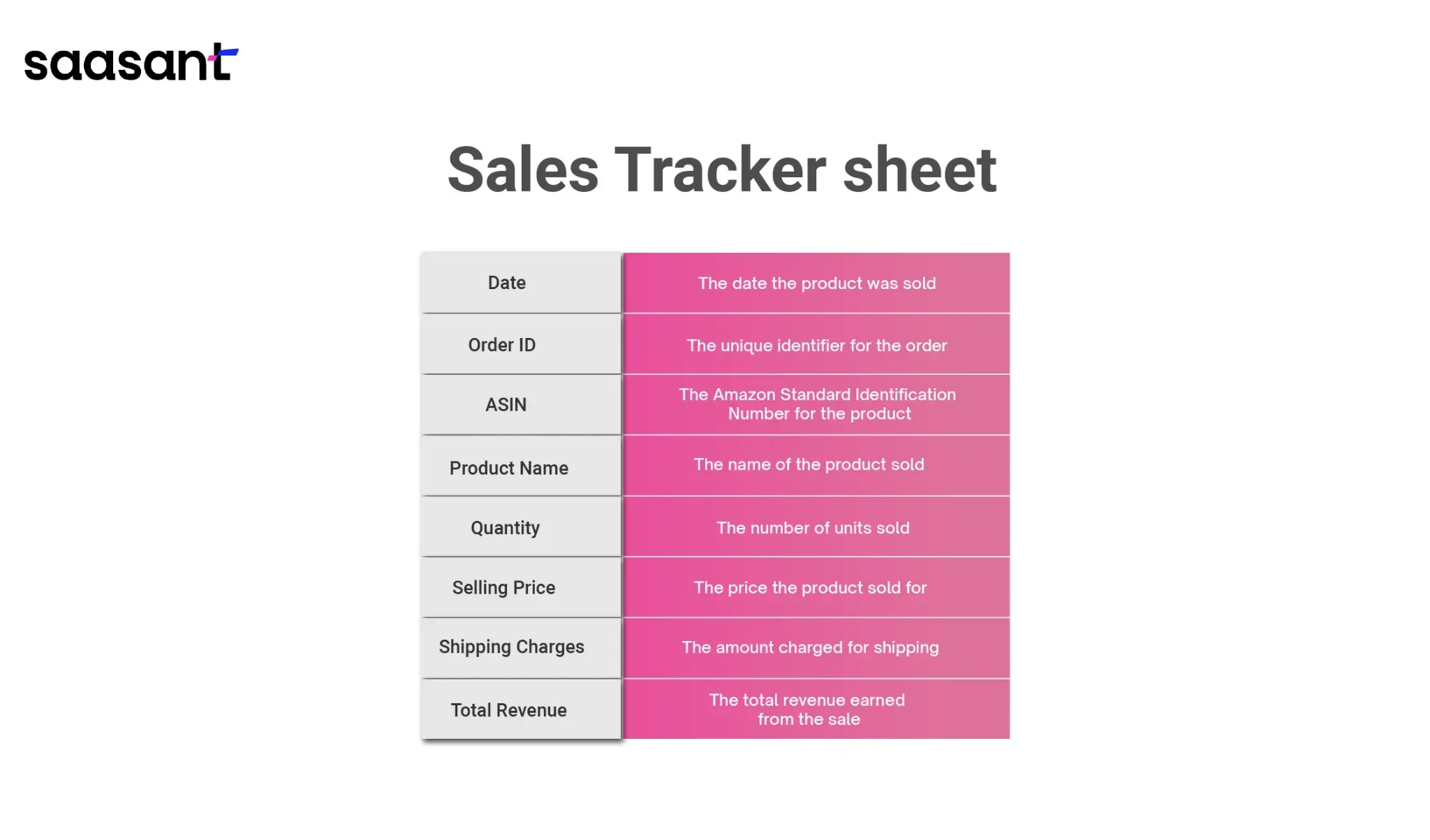
Expense Tracker
This feature should allow the seller to input expenses related to the business, such as FBA fees, shipping costs, inventory costs, and other expenses. The spreadsheet should automatically calculate the total expenses for each category and provide a clear overview of the total costs incurred.
Column Details in the Expense Tracker sheet:
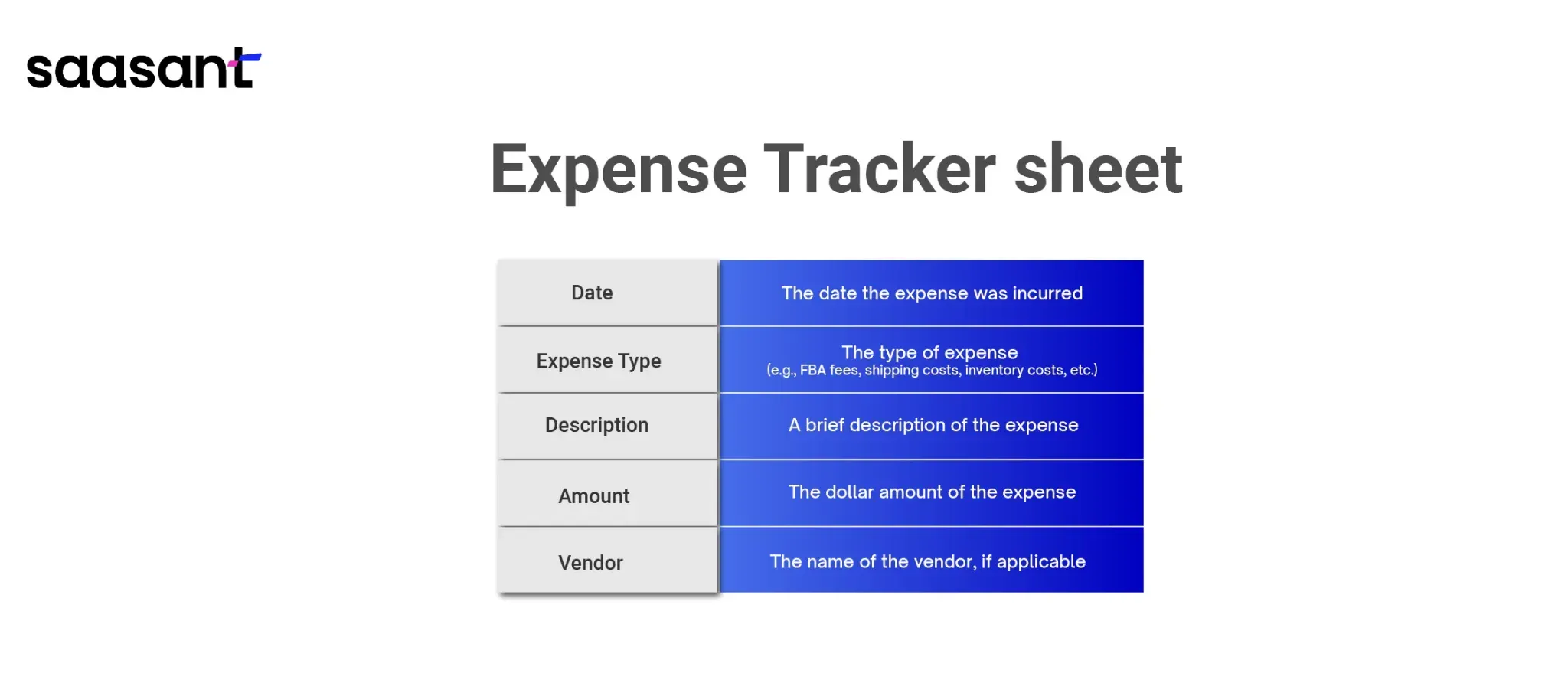
Inventory Tracker
This feature should allow the seller to track the quantity and value of inventory held in Amazon’s warehouses. The seller can input information about the cost of goods sold for each product and the units in stock. The spreadsheet can then calculate the total inventory value and provide an overview of inventory levels.
Column Details in the Inventory Tracker Sheet:
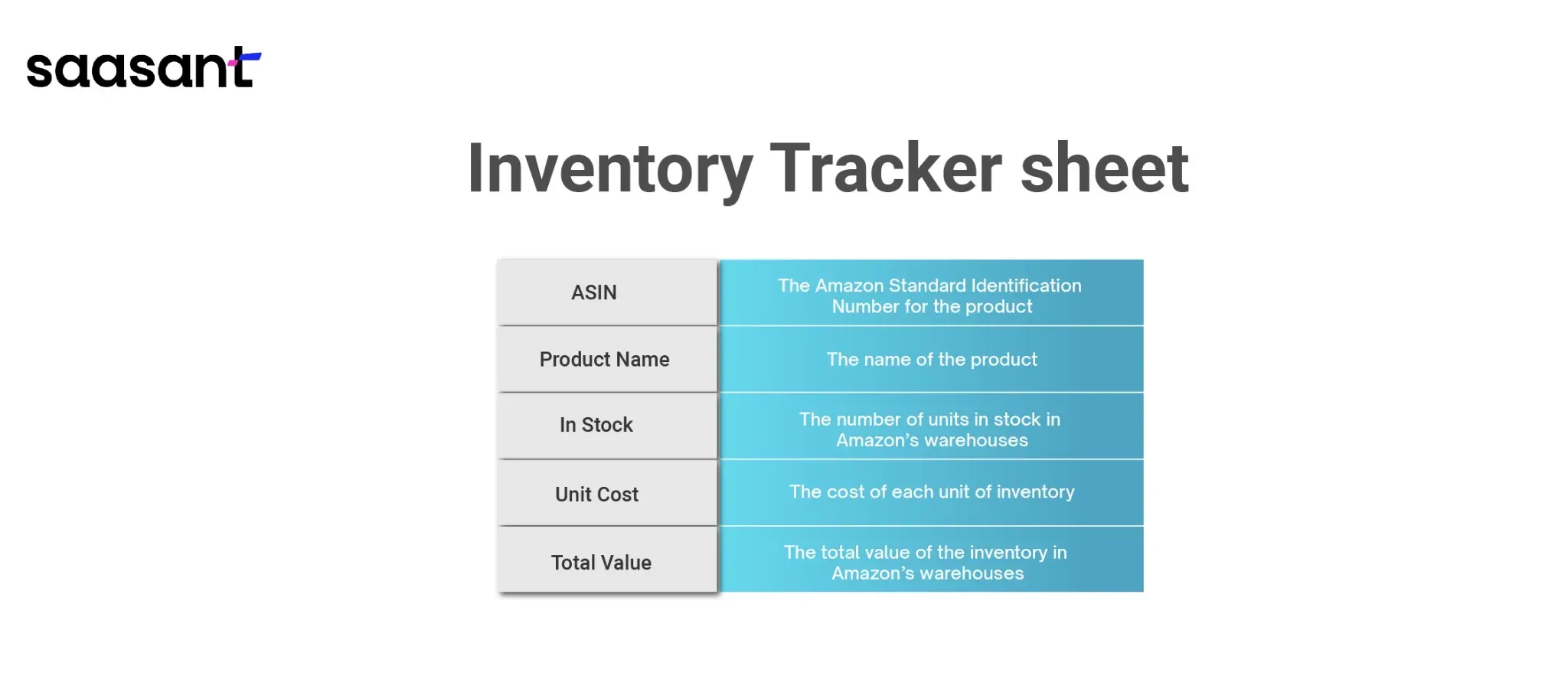
Sales Tax Tracker
This feature should allow the seller to input data related to sales tax collected and remitted in each state where the business is required to collect sales tax. The spreadsheet can automatically calculate the sales tax owed and provide an overview of the business owner’s equity sales tax liability.
Column Details in the Sales Tax Tracker Sheet:
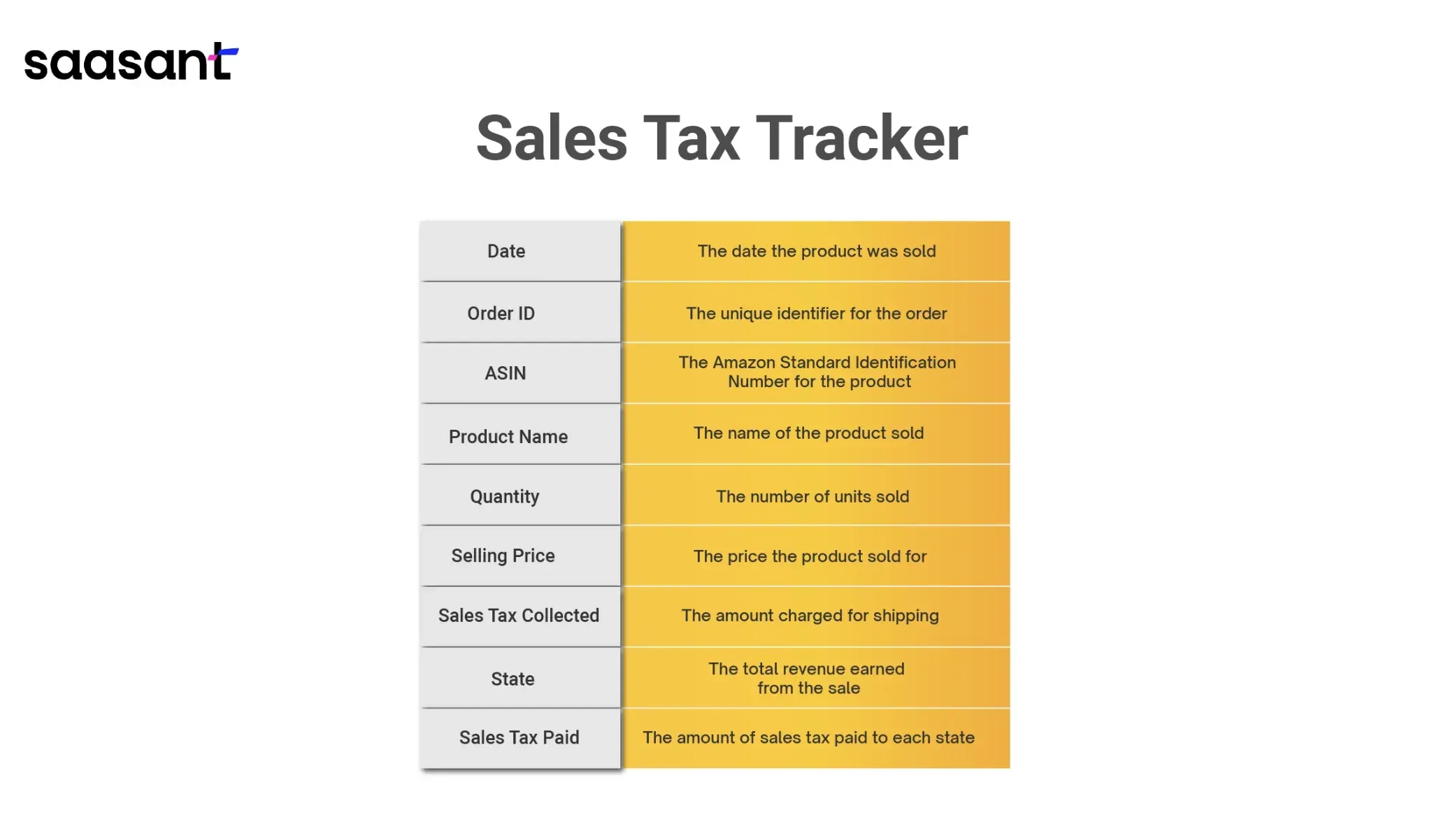
Reporting
The spreadsheet should generate clear and concise reports on key financial metrics, such as revenue, expenses, and profit. These reports can help the seller make informed business decisions and identify areas where the business can improve its financial performance.
Column Details in the Sales Tracker Reporting Sheet:
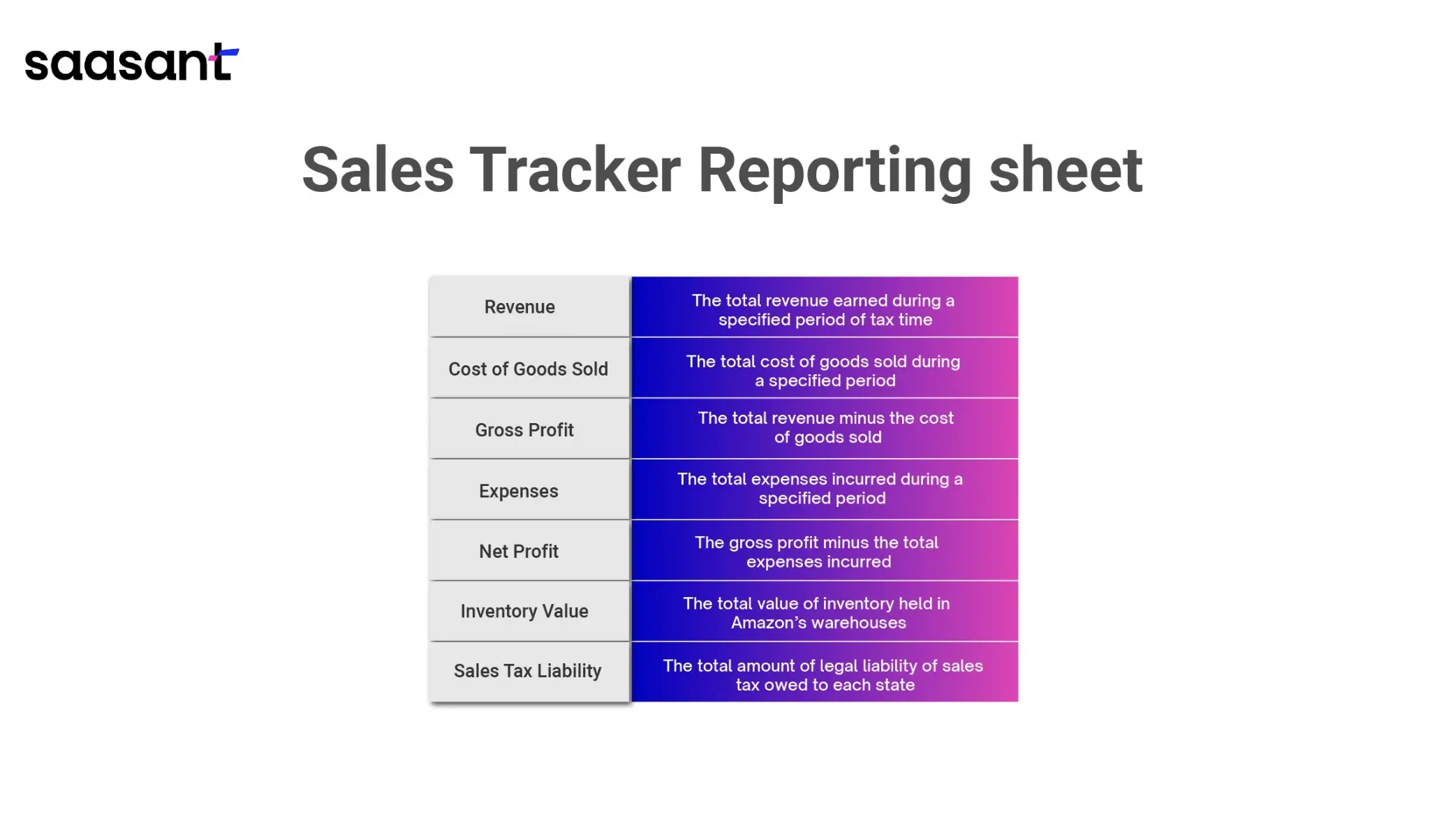
Amazon Seller Tax Services
Amazon Seller Tax Services are professional tax services that assist small businesses and individuals selling products on Amazon to comply with tax laws and regulations. These services can help sellers navigate the complex and often confusing world of taxes, ensure they pay the correct amount, and file their tax returns accurately and on time.
Some of the services that Amazon Seller Tax Services might provide include:
Sales Tax Compliance
Amazon Seller Tax Services can help sellers comply with state sales tax laws and regulations by guiding registering for sales tax, collecting and remitting sales tax, and filing sales tax returns.
Income Tax Planning and Preparation
These services can help sellers with income tax planning and preparation, including calculating estimated tax payments, tax time, preparing and filing tax returns, and maximizing deductions and credits.
International Tax Compliance
Amazon Seller Tax Services can also assist with international tax compliance, such as advising sellers on tax implications of cross-border sales, VAT registration, and compliance with foreign tax laws.
Bookkeeping and Accounting
Many Amazon Seller Tax Services also offer bookkeeping and accounting services, including maintaining accurate records of sales and expenses, reconciling bank statements, and preparing financial statements.
Audit Representation
In the event of an audit by the IRS or state tax authority, Amazon Seller Tax Services can represent the seller and assist with responding to audit inquiries and providing necessary documentation.
Maximizing Efficiency and Accuracy in Amazon Bookkeeping: Bookkeeping Services That Can Help You
Applications like PayTraQer and SaasAnt Transactions can be valuable tools for small business owners and individual sellers who want to streamline their Amazon bookkeeping process. These apps can integrate with bookkeeping software, such as QuickBooks, and offer additional features that make tracking finances more effortless and efficient.
PayTraQer simplifies the bookkeeping process by automatically categorizing transactions and providing an easy-to-use interface that allows sellers to track inventory and monitor their financial performance. SaasAnt Transactions, on the other hand, offers powerful automation features, such as bulk import and export of transactions, that save time and reduce the risk of errors.
Using these applications can help sellers maintain accurate records, comply with tax laws and regulations, and make informed financial decisions. By integrating these tools with their bookkeeping software, sellers can create a seamless workflow that reduces their bookkeeping burden and allows them to focus on growing their business. Overall, PayTraQer and SaasAnt Transactions are potent tools that can make Amazon bookkeeping more efficient and effective.
FAQs
Does Amazon offer Bookkeeping Services?
No, Amazon does not offer bookkeeping services. However, Amazon provides various tools and reports to help sellers manage their finances and track their sales.
What is The Rate Per Hour for Bookkeeping?
The hourly rate for bookkeeping varies depending on the bookkeeper's location, experience, and qualifications. In the US, the average hourly rate for a bookkeeper ranges from $20-$50 per hour.
How to Do Amazon Accounting?
To do Amazon accounting, sellers need to track their sales, expenses, and inventory using bookkeeping software like QuickBooks, Xero, etc. It involves categorizing transactions, reconciling bank statements, and generating financial reports.
What Accounting Method Does Amazon Use?
Amazon employs the accrual accounting method for its financial reporting, which entails recording revenues and expenses when they are incurred rather than when cash is received or paid.
How Do You Forward Amazon Detailed Receipts to the Bookkeeper?
Sellers can forward Amazon detailed receipts to their bookkeeper by accessing their order history and selecting the “view order details” option. Sellers can download the receipt from there and forward it to their bookkeeper.
How Do You Start a Bookkeeping Business on Amazon?
To start a bookkeeping business for Amazon sellers, individuals must understand bookkeeping principles and experience purchasing inventory on Amazon’s marketplace. They can then market their services to small business owners or individuals who sell products on other e-commerce businesses on Amazon.
How Do You Apply as a Bookkeeper for Amazon Sellers?
To apply as a bookkeeper for Amazon sellers, individuals can search for job postings on Amazon’s job board or freelance platforms, such as Upwork or Fiverr. They may need relevant qualifications and experience in bookkeeping and working with Amazon sellers.